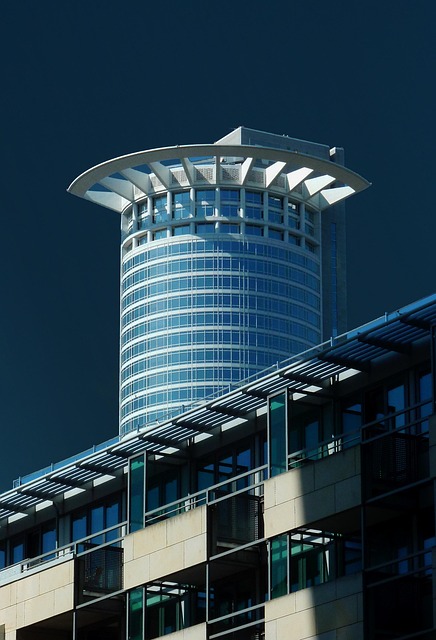Architects must balance aesthetics with ecology in structure design, focusing on sustainable roof strategies like green roofs and living walls. These methods mimic natural landscapes, offering environmental benefits such as improved energy efficiency, biodiversity support, and water management. Integrating native flora and understanding local climate fosters harmony between built environments and nature. Biophilic design trends, exemplified by global projects like the Amazon Forest Tower, showcase successful unions of architecture and nature. Future advancements in sustainable roof technology will enhance eco-friendly urban planning.
In an era where architecture and nature increasingly intersect, designing structures that seamlessly blend with their surroundings is more crucial than ever. This article explores the art of tailoring designs to harmonize with natural landscapes and existing architectural elements. We delve into the environmental impact of architecture, highlighting the significance of sustainable roof design as a key strategy for achieving ecological balance. Through case studies and future trends, we showcase innovative approaches that demonstrate how buildings can become an integral part of their environment.
Understanding the Impact of Architecture on Natural Environments
The relationship between architecture and its natural surroundings is a delicate balance. When designing structures, architects must consider how their creations will interact with the existing environment, both visually and ecologically. This understanding is crucial for implementing sustainable roof designs that harmonize with the landscape, minimizing the impact on local ecosystems.
One of the key aspects to navigate is scale and materiality. Incorporating design elements that reflect and complement the surrounding terrain can help blend the built environment into the natural one. For instance, using materials that mimic local geology or incorporating sustainable roof designs like green roofs or living walls can reduce the visual impact and create a more harmonious relationship between architecture and nature.
The Role of Sustainable Roof Design in Environmental Harmony
The integration of sustainable roof design plays a pivotal role in achieving environmental harmony with natural surroundings and architectural structures. This approach involves creating roofs that are not only aesthetically pleasing but also functional, offering numerous ecological benefits. By adopting sustainable practices, such as incorporating green vegetation or using eco-friendly materials, these designs minimize the environmental impact of buildings while enhancing their overall beauty.
Sustainable roof design contributes to a building’s energy efficiency by providing natural insulation and temperature regulation. Additionally, it supports biodiversity by creating habitats for local flora and fauna. Furthermore, sustainable roofs can help with water management by absorbing and filtering rainwater, reducing the strain on drainage systems. This holistic approach ensures that architecture complements its context, fostering a harmonious relationship between human-made structures and the natural world.
Integrating Design Elements: Blending with Surroundings
In the pursuit of harmonious architecture, integrating design elements that blend seamlessly with natural surroundings is paramount. Sustainable roof designs play a pivotal role in this endeavor. By incorporating green roofs or living walls, designers can transform flat rooftops into vibrant ecosystems, mimicking the surrounding landscape. These organic features not only enhance aesthetics but also offer environmental benefits, such as improved insulation, reduced urban heat islands, and stormwater management.
The key lies in understanding the local climate, topography, and flora. Careful selection of plants native to the region ensures their adaptability and longevity, fostering a genuine connection between the built environment and its context. This approach promotes biodiversity, creates visual allure, and fosters a sense of tranquility, ultimately elevating the overall experience of those who inhabit or pass by these spaces.
Case Studies: Successful Examples of Tailored Architectural Designs
In recent years, there has been a growing trend among architects and designers to create structures that seamlessly blend with their natural surroundings. This approach, often termed “biophilic design,” not only enhances aesthetics but also offers ecological benefits. One prominent example is the use of sustainable roof designs, where green roofs or living roofs are integrated into architectural structures. These designs provide insulation, reduce heat island effects, and support biodiversity by creating habitats for local flora and fauna.
Case studies from around the globe illustrate the success of tailored architectural designs. For instance, the Amazon Forest Tower in Berlin, Germany, incorporates a vertical forest on its exterior, mimicking the surrounding natural landscape. Similarly, the Edge building in Amsterdam employs a living wall and extensive roofing, contributing to its certification as one of the world’s most sustainable buildings. These projects demonstrate that by thoughtfully integrating nature into the design process, architects can create iconic structures that are both visually stunning and environmentally responsible.
Future Trends: Innovations in Sustainable, Environmentally-Conscious Architecture
The future of architecture is increasingly tied to sustainability and environmental consciousness, with innovative designs that blend seamlessly into natural landscapes. One prominent trend is the rise of sustainable roof design, which goes beyond basic functionality to create vibrant green spaces. These living roofs, or green roofs, offer numerous benefits, including improved insulation, reduced urban heat islands, and enhanced biodiversity. They also provide an opportunity for architects to create visually stunning features that mimic nature’s beauty.
By integrating natural elements into their structures, architects are moving away from the traditional concrete and glass boxes. This shift fosters a harmonious relationship between buildings and their surroundings, making them less intrusive on ecosystems. As technology advances, we can expect more sophisticated materials and systems designed to optimize energy efficiency, minimize waste, and promote circularity, further solidifying sustainable architecture’s place in the future of urban planning.
In conclusion, the harmonious integration of architecture with natural surroundings is not just an aesthetic ideal but a crucial consideration for sustainable development. By understanding the impact of architectural designs on ecosystems and adopting innovative solutions like sustainable roof design, we can create structures that blend seamlessly into their environments. The case studies presented highlight successful examples of tailored architectural blends, offering valuable insights for future projects. As the field of environmentally-conscious architecture continues to evolve, embracing sustainable practices and exploring creative design elements will be essential in preserving our planet’s beauty while accommodating humanity’s built environment needs.
